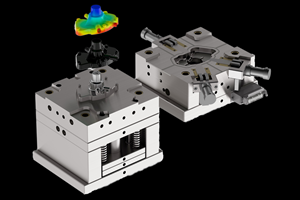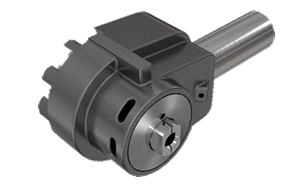The Benefits of Hand Scraping
Accuracy and flatness are two benefits of hand scraping that help improve machine loop stiffness, workpiece surface finish and component geometry.
The use of hand scraping in machine tool manufacturing to increase accuracy levels has become less widespread with advancements in process control and machine stiffness. However, the benefits of hand scraping still exist when it is carried out in a controlled manner.
Hand scraping is the process of using either a manual or motor-driven scraping blade to remove very small amounts of metal from a precision surface to eliminate high spots left behind by the machining process. This provides a flat, accurate bearing surface onto which machine components can be mounted. By increasing the bearing contact area between the mating surfaces, joint rigidity is increased in the machine tool.
There are about 25 key surfaces that should be scraped on a vertical machining center to allow the machine to be “fitted” together rather than “assembled” for increased structural rigidity. Such fitted surfaces include, for example, column to base components, spindle cartridge to spindle housing, ballscrew bearing block seats to bearing retainer and worktable to linear guide truck face. Once this is accomplished, the end user will be able to take aggressive rough cuts followed by extremely fine finish cuts, improving tool life and surface finish, and reducing cycle times.
Accuracy and flatness are two key advantages of hand scraping, leading to improvements in machine loop stiffness, workpiece surface finish and component geometry. Machine loop stiffness and workpiece surface finish are improved by better contact areas of mating components. When a component is finish-machined, either by milling or grinding, small imperfections in the surface integrity or flatness are left behind. Then when two mating components are fitted, their structural rigidity is compromised, because the inconsistent surfaces are not truly “flat.” Hand scraping removes the high points to ensure additional contact for mounting. With hand scraping, the amount of contact over a given area of two mating components can exceed 50%, with 10 or more contact points per square inch. This improved contact enables machining forces to be passed through the structure to its strongest areas and helps prevent cutter impact frequencies from generating chatter.
Component geometry also is improved through refinements in machine tool geometry. Hand scraping to qualified masters or gages removes surface imperfections, improving machine tool geometry. Once hand scraping is completed, alignments, including straightness, are greatly improved. This ultimately reduces the amount of electronic compensation required on the machine tool. For example, ballscrew brackets can be aligned to closer limits, improving laser interferometry results (a method for measuring distances with great accuracy) and reducing required electronic compensation levels. Axis straightness can also be improved by limiting the effects of roll, pitch and yaw. And squareness errors can be reduced to a few microns. All of this leads to improved volumetric accuracy within the machine tool that helps the end user achieve higher-accuracy parts and raises confidence that these accuracies are obtainable throughout the entire volume of the machine.
Another classic example of where hand scraping is beneficial is in the alignment of a spindle to Z-axis motion. In most machine structures, this is achieved by pitching the spindle in the head casting and scraping the mounting face of the spindle flange. As this is one of the final alignments made in the setup process, it is not something that can be machined into the head casting and must be scraped after geometric checks have been made.
A machine tool with better mating surfaces of its key components will provide consistent results over a longer period of time and will require less rework. With careful scraping methods, a typical lifetime in excess of 10 years is not uncommon and can often be comfortably exceeded.
Related Content
Tips for Tackling Mold Design, Machining, Cutting Tool and Wear Challenges
Tips for tasks ranging from reducing risk in part design and taking advantage of five-axis machining to refining cutting tool performance and reducing wear with guiding and centering systems.
Read More3D Printing Enables Better Coolant Delivery in Milling Operations
Just like 3D printing enabled conformal cooling channels in molds, additive manufacturing is now being used to optimize coolant delivery in cutting tools.
Read MoreDevelopments in High-Speed Machining Technology
There have been many exciting developments in high-speed machining relative to machining centers and controls, tooling and CAD/CAM systems.
Read MoreRead Next
Reasons to Use Fiber Lasers for Mold Cleaning
Fiber lasers offer a simplicity, speed, control and portability, minimizing mold cleaning risks.
Read MoreHow to Use Continuing Education to Remain Competitive in Moldmaking
Continued training helps moldmakers make tooling decisions and properly use the latest cutting tool to efficiently machine high-quality molds.
Read MoreHow to Use Strategic Planning Tools, Data to Manage the Human Side of Business
Q&A with Marion Wells, MMT EAB member and founder of Human Asset Management.
Read More












_300x250 3.png;maxWidth=300;quality=90)












